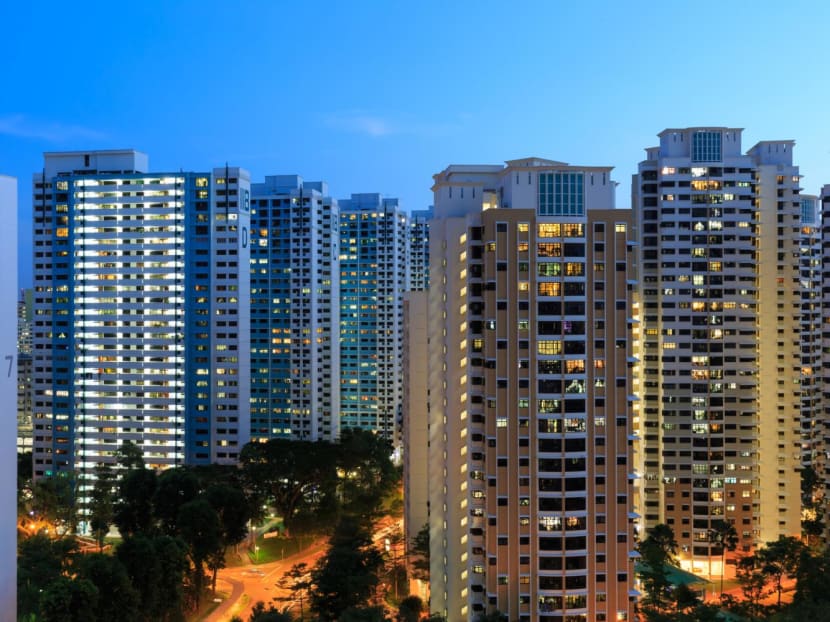Open Electricity Market still viable, but stronger foundation needed after retailers’ exits: Tan See Leng

HDB flats at night. (Photo: iStock)
SINGAPORE: Singapore’s Open Electricity Market (OEM) remains beneficial for consumers and viable despite the recent exits of at least five electricity retailers, Second Minister for Trade and Industry Tan See Leng said in Parliament on Monday (Nov 1).
But the foundations of this initiative, which allows consumers in Singapore to choose their preferred electricity provider, will need to be strengthened as they have proven to be “insufficient” for a “severe stress test” such as the ongoing global energy crisis, Dr Tan said in response to a series of parliamentary questions filed on the issue.
In October, a string of electricity retailers – iSwitch, Ohm Energy, Best Electricity, UGS Energy and SilverCloud Energy – called it quits citing volatile market conditions. Dr Tan said these five retailers supply to about 9 per cent of all electricity consumers, including both residential households and commercial users.
Such successive departures have sent shockwaves across the country and raised questions about the move to open up Singapore’s electricity market to as many as a dozen retailers.
Dr Tan acknowledged these concerns but he said that since the launch of the OEM in end-2018, consumers have been able to “enjoy increased choice and flexibility” when buying electricity, as well as savings of up to 30 per cent off the regulated tariff for those who switched to a retailer.
To date, about 746,000 households – or about 50 per cent of all households – in Singapore have switched to buying electricity from a retailer, instead of getting power from SP Group at the quarterly-reviewed regulated tariff.
“Notwithstanding the recent exits, the OEM has benefited and continues to benefit many Singaporeans,” he told the House.
The initiative to fully liberalise the electricity retail market in Singapore also remains viable, said Dr Tan, who is also Manpower Minister.
Nine retailers remain at the moment and depending on the severity and duration of the energy crunch, more may choose to either exit or re-enter the market, he added.
Referring to questions about whether the Energy Market Authority (EMA) will be reviewing the number of electricity retailers, the minister said: “The answer is that there is really no magic number. There is sufficient competition in the OEM today and EMA is committed to ensuring this.”
Still, the foundations of the market will need to be strengthened.
At the moment, electricity retailers are “vetted” and have to fulfil a “stringent set of requirements” before being issued a licence. These requirements include submitting financial statements to the EMA and consistently hedging at least 50 per cent of their wholesale electricity price risk.
“On hindsight, these are necessary but for a severe stress test such as this, the measures were insufficient … Some retailers were ill-prepared to weather the storm,” said Dr Tan, adding that authorities will consider the various suggestions raised by Members of Parliament (MPs) on how to strengthen these requirements and the electricity futures market.
He noted that the EMA will enhance its licensing requirements for electricity retailers and strengthen consumer protection moving forward, although such safeguards will need to be done in a “practical and realistic” manner.
“Because it would be neither feasible nor economically prudent for us to institute safeguards that can cover every potential possible eventuality. I think doing so will lead to significant costs for consumer,” he said, in response to supplementary questions by MPs.
Dr Tan also stressed that electricity retailers here are not “some fly-by-night companies out to make a quick buck and walk away when the prices of electricity or prices move against them”.
“This applies even to the retailers that have already exited. This round, the crisis was unprecedented and there are significant challenges to retailers,” he added.
EXITS ARE FEATURES OF OPEN MARKET
There are two types of retailers in the OEM – the “gentailers” that generate and sell electricity; and the independent retailers that do not generate their own electricity but buy electricity from the wholesale market where prices change every 30 minutes depending on demand and supply.
Independent retailers are generally able to offer retail prices lower than the regulated tariff over the past few years due to depressed wholesale electricity prices amid an overcapacity in generation and oversupply of gas, Dr Tan said.
The electricity futures market, set up in 2015, also allowed retailers to hedge their price risks through electricity futures. Retailers can also offlay their risk to generation companies, or “gencos”, through financial hedges such as contracts for differences, the minister added.
These have worked well in a stable market environment, said Dr Tan. But given the recent volatile conditions in the wholesale electricity market amid a confluence of shock factors in the global energy market, several retailers found themselves to be unprepared and were “under-hedged”.
“These retailers now find themselves having to buy the unhedged portion of electricity at the high wholesale electricity prices and sell them at much lower contracted rates to consumers.”
Liquidity in the electricity futures market has also been affected.
“Given the huge volatility, market makers were not prepared to take on significant positions. This is similar to the situation in other commodity markets,” the minister added.
“As a result, some electricity retailers are no longer able to sustain their operations in this challenging environment and have chosen to exit the market.”
Dr Tan said the entry and exit of retailers are “features of an open and competitive retail market”, with the unusually high number of exits recently reflecting the severity of the global energy shock. A similar phenomenon is also being observed in other countries, such as the United Kingdom and Spain.
“The key is to have a fair and robust system to ensure a smooth transition for customers affected by exiting retailers,” he said, while reiterating existing safeguards such as how retailers exiting the market are not allowed to charge an early termination fee and will have to refund any remaining security deposits after offsetting outstanding charges.
Authorities have also given the assurance that there will be no disruption to the electricity supply of affected customers.
As of end-October, about 140,000 households and 11,000 business accounts will either be transferred to another retailer or back to SP Group. Consumers who are transferred to the SP Group can choose to purchase electricity from another retailer, Dr Tan said.
Addressing questions on whether SP Group can continue to honour the prices and contract terms of exiting electricity retailers for those affected, Dr Tan said the regulated tariff reflects the price SP pays to the generating companies for the electricity.
“For the transferred customers to pay less, the other consumers with SP will have to pay more than the regulated tariffs to cross-subsidise them.”
Meanwhile, EMA is working closely with the remaining electricity retailers by facilitating their efforts to hedge against future price volatility, while also working with the Singapore Exchange to “incentivise more market makers to participate in the electricity futures market”.
ASSITANCE ON ELECTRICITY PRICES
Dr Tan told the House that his ministry, together with the Ministry of Finance, is monitoring the situation of electricity prices in Singapore and studying whether further assistance is needed for affected households and businesses.
The Government has been providing targeted assistance to those eligible, such as the U-save rebates which help lower and middle-income families with utility expenses. There are also programmes to raise awareness of electricity conservation among households and businesses, he added.
Given Singapore’s reliance on energy imports, the country cannot be fully insulated from developments in the global energy market, Dr Tan said.
So far, most consumers in Singapore have been somewhat cushioned as 99 per cent of households are on standard price plans offered by the retailers or paying the regulated tariff. Meanwhile, about 96 per cent of businesses are on fixed price or discount-off-tariff plans.
“These have risen by far less than the price of gas or wholesale electricity,” Dr Tan said. “However, sustained high fuel prices will eventually feed into our electricity bills to reflect the cost of electricity production.”
ENERGY SECURITY
Turning to the issue of energy security, Dr Tan said measures have been put in place over the years to secure Singapore’s access to fuel supplies.
For one, the country has had long-term supply contracts for piped natural gas from Malaysia and Indonesia since 1999, and negotiations to renew some of these contracts are ongoing.
This supply has been “relatively stable”, although an incident that occurred at an upstream gas production facility in July has affected gas supply from Indonesia’s West Natuna, resulting in a 3 per cent fall in overall gas supply to Singapore since September.
This is likely to last until the end of the year as the facility undergoes repair and upgrading, said Dr Tan.
In addition, gas supply from South Sumatra has also been affected due to higher demand from gas users upstream. EMA is working with gas importers to stabilise the supply of piped natural gas, he added.
Among other measures, “gencos” are also required to stockpile at least 60 days of fuel reserves in the event of disruptions to natural gas supply. This stockpile “remains intact”, according to the minister.
EMA also ensures that there is sufficient generation capacity to convert the fuel to electricity.
“Taking into account planned and unplanned outages, we need to maintain spare generation capacity or reserve margin of at least 27 per cent above peak electricity demand. Today, the reserve margin stands at 52 per cent. It is still significantly above the 27 per cent,” he said.
Over the last 10 years, the excess capacity had been higher mainly due to over-investment by private “gencos” in the early 2010’s. But moving forward, the country “cannot always assume that the private sector will put in sufficient investments to build new generation capacity”.
As such, this matter will be addressed in the Energy (Resilience Measures and Miscellaneous Amendments) Bill scheduled for Parliament’s sitting on Tuesday, Dr Tan added.
Meanwhile, the EMA has announced a series of “extraordinary” pre-emptive measures, such as setting up stand-by fuel facilities for “gencos” draw upon if needed. The authority will review if these measures are still needed by March 2022.
Dr Tan said: “These pre-emptive measures are extraordinary, but they are also necessary to secure our fuel and electricity supply during this extraordinary period”.
In the longer run, Singapore will continue to diversify its energy sources where possible. For instance, it recently announced plans to import up to 4 gigawatt of low-carbon electricity by 2035 so as to decarbonise its power system and reduce reliance on natural gas
Singapore will also explore other low-carbon alternatives like hydrogen and geothermal energy.
Together, these measures will make the country’s power system more resilient and less susceptible to price and supply risks, the minister said.
“Our energy market has served us well for the last 20 years. Amongst major cities, our electricity supply is one of the most reliable and price competitive,” Dr Tan told the House.
“Our market is now being tested by an unprecedented storm in the global energy market. While most consumers will not see an immediate increase in electricity prices, they may see an increase next year with increasing energy prices globally.
“Our commitment to this House is this: We will secure our energy supply. We will help vulnerable consumers weather the storm and we will continue to make our energy sector even better,” he added.












